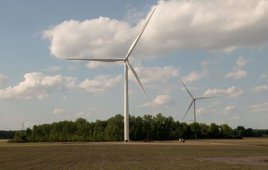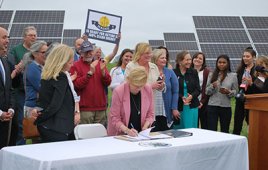Component failure, and operation and maintenance issues are a problem with any part of a wind turbine, especially electrical components. Thankfully, manufacturers have noticed the failure rates and started to do something about them.
Ultracapacitors
Ultracapacitors in wind turbines power pitch control systems and voltage regulations. Maxwell Technologies explains ultracapacitors provide burst power for electric blade-pitch control systems to ensure rotor speed remains within a safe operating range and optimize wind turbine output. The company’s ultracapacitors offer long life (one million charge-discharge cycles) and maintenance-free capability, resulting in low lifecycle cost and reliable power backup. In particular, the company’s 56-V UPS modules provide power during dips in the power source for industrial applications. In longer term outages, the modules provide transition/bridge power to a longer term back up source such as a motor-generator or fuel cell. These devices have proven successful in industrial applications and the company is certain the models will be effective in the wind industry as well.
Other industry trends, says Maxwell Technologies, is in cost reduction through integration. Larger capacitor modules are replacing smaller ones. This results in fewer modules per turbine, which reduces cost and assembly time. Another is in curtailment.
In a recent conference, Gary Moland, director of market analysis with GL Garra d Hassan, discussed problems with curtailment and congestion. Curtailment occurs when wind farms must reduce their generation output due to congestion on a transmission grid with inadequate capacity. He says curtailment studies can help quantify risk on a regional and local level. Meanwhile, Maxwell Technologies is focusing on stabilizing wind output to improve grid integration and reduce curtailment. This will make wind more profitable with higher output for longer periods of time.
Circuit breakers
These allow working on high-voltage equipment by electrically isolating it when necessary. Recent compact circuit breakers let panel builders place voltage transformers in the top compartment of the switchgear, which reduces the switchgear footprint from that needed by older equipment. In one version, pole units are encapsulated to protect high-voltage components from the environment, and motorized levering allows remotely racking (installing or removing) the breaker for enhanced safety. Recent designs also eliminate SF6, a potentially hazardous gas used as an insulator instead of air inside some switchgear.
Remote racking allows inserting and removing breakers while standing outside a arc-flash boundary (high voltage can jump an air gap and produce a fatal shock) and increase the distance between the operator and the front of the switchgear lineup during racking operations.
What’s more, breakers engineered for wind applications can be customized. Such accessories facilitate and simplify integrating the breaker into switchgear. A few custom features include self-aligning and coupling primary and secondary disconnecting devices, and rip-free interlocks prevent moving a closed breaker into and out of the connect position.
Transformers
Historically, transformers on wind farms have been conventional, off-the-shelf distribution units. But, after a relatively large number of failures, transformer manufacturers have changed their strategy and begun designing wind-farm specific transformers. Key characteristics of the new models include alterations to transformer loading, harmonics and non-sinusoidal loads, voltage variations, transformer sizing, and special requirements to handle faults. According to Tom Steeber with Pacific Crest Transformers, “A transformer designed specifically for a particular application will hold up dependably, while standard off-the-shelf transformers may fail if not designed with the needs of an application in mind.”
Transformer operating costs are also an issue the industry is addressing. ABB’s Transformer Design Specialist Doug Getson puts it into perspective, “Transformer losses are measured at load and no-load,” he says. “Even when they aren’t working hard, transformers are consuming power often priced from $2 to $8 per Watt over a 20-year equipment life. A 0.5 to1% boost does not sound like much but consider the many transformers on a wind farm and you suddenly see the operator could be losing a significant sum.”
Utilities often consider a transformer’s total cost of ownership as the unit’s price tag plus the cost of operation. So even though more efficient transformers cost more up front, over a 20-year life a typical high-efficiency transformer can save about $11,000. Now multiply that by the number of turbines on the farm and there’s substantial savings. WPE
Filed Under: Uncategorized





In power stations we have to manage many problems in transformers and other components. Checking the electronic components periodically and replace defected component can avoid such problems.